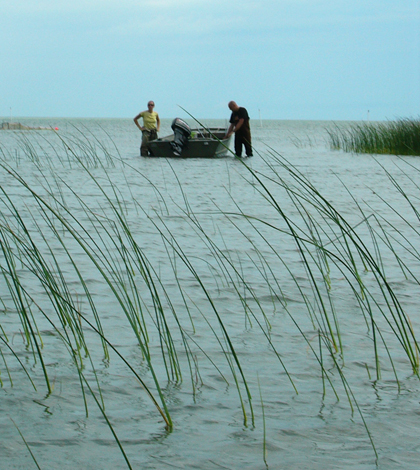Five-year Great Lakes coastal wetlands monitoring campaign updates public on progress

A sampling crew progresses along a Great Lakes coastal wetland (Credit: Matthew Cooper)
Since 2011, researchers from nine universities, two federal agencies and a Canadian non-profit have slogged through the mud of coastal wetlands across the Great Lakes coasts to collect samples and monitor water quality.
Speakers said in a webinar hosted by Sustaining our Great Lakes said that the research is vital to restoration and understanding basin-wide health. The work is funded by the U.S. Environmental Protection Agency through the Great Lakes Restoration Initiative.
Researchers should be able to give an overall assessment of wetlands in the Great Lakes region by the time the study is complete in 2015. In the meantime, the data collected so far shows wetlands in the lower Great Lakes are in the worst shape, as they’re adjacent to concentrated human populations.
“The lower Great Lakes are more disturbed, with respect to the vegetation, than the upper Great Lakes,” said Todd Hogrefe, Great Lakes Program Director of the National Fish and Wildlife Foundation, which administers funding to Sustain Our Great Lakes. “A large part of this is based on just vegetative invasive species.”
Hogrefe said the Great Lakes coastal wetlands monitoring program was designed to obtain a representative picture of the basin-wide conditions. New sampling locations have been chosen each year by randomly selecting wetlands in different regions of the Great Lakes. Data is also collected at long-term study sites.

The monitoring program includes sampling for macroinvertebrates, amphibians, birds, vegetation and fish (Credit: Matthew Cooper)
Matthew Cooper, a doctoral student of water sciences at the University of Notre Dame, said that data collection has helped strategize restoration approaches.
Launching a wetland restoration prompts many questions, such as where to focus efforts and resources, how to effectively improve the area and how to maintain the land once complete.
“These are mostly sociopolitical or economic decisions, but they require good data to make these decisions in a strategic and efficient way,” Cooper said.
Cooper and a team of researchers analyzed Sensiba, a wetland section of Green Bay West Shore Wildlife Area, prior to restoration. Thier work detected a decline in biodiversity in an area of diked wetlands compared to wetlands outside the structures.
Cooper said the team sampled fish and found the index of biotic integrity was 20 points less inside the dyke than outside the dyke. Data from the coastal wetland program gave the researchers a regionally broad baseline against which they could compare those results.

The program monitors fish with fyke nets (Credit: Matthew Cooper)
The analysis showed the majority of species found inside the dyke were tolerant hardy fish. Outside the dyke there were much more sensitive and recreationally desirable.
The basin wide study will improve researchers overall understanding of Great Lakes wetland health and give scientists across the U.S. and Canada reference data for future work in the Great Lakes. Hogrefe said a database will soon be online, hosting data from the Great Lakes coastal wetland monitoring program for scientists and the general public.




0 comments